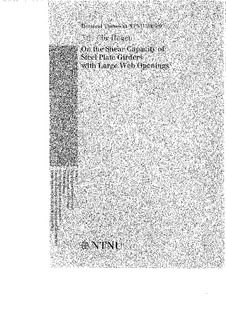| dc.contributor.author | Hagen, Nils Chr | nb_NO |
| dc.date.accessioned | 2014-12-19T11:24:30Z | |
| dc.date.available | 2014-12-19T11:24:30Z | |
| dc.date.created | 2007-02-27 | nb_NO |
| dc.date.issued | 2004 | nb_NO |
| dc.identifier | 122079 | nb_NO |
| dc.identifier.isbn | 82-471-6878-2 | nb_NO |
| dc.identifier.uri | http://hdl.handle.net/11250/231149 | |
| dc.description.abstract | This report presents an investigation of the shear capacities of steel plate girders with web holes, penetrations, cut-outs or openings. The study is motivated by the need for simple guidelines that can be used in practical design of girders in building and offshore structures. Simplicity of method is highly desireable because the value of any calculation decreases sharply if it is not completed before the design is frozen.
The study comprises a review of existing load-carrying theories, including methods based on allowable stresses, strength criteria, simplified shear buckling, rotated stress fields,tension and stressed skin.
260 simulations of girders are performed by means of the non.linear finite element program ABAQUS. Results from experiments of large plate girders are used to calibrate the finite element models, in order to ensure that reliable models are used in the simulations.
The simulations comprise girders with webs of height-thickness ratios from 63 to 333. The openings are circular, elongated circular, square and rectangular, with and without sleeves, doubler plates, vertical stiffeners and horizontal reinforcement. Opening sizes are 25% and 50% of girder heights. SIngle openings and two openings close together are included.
The shear capacites and transverse web displacements in the various limit states are discussed. A new design procedure is proposed for girders with openings. Here, the calculation of the shear capacity in the ultimate limit state (ULS) is linked to the Eurocode 3 for girders without openings. A simplified moment-shear interaction equation is also proposed. A set of design guidelines is given for design based on the LRFD method.
For more complicated cases, and for design in the accidental limit state (ALS, non-linear FE-models may be required. Recommentations for such models are given, based on the experience from the simulatons. | nb_NO |
| dc.language | eng | nb_NO |
| dc.publisher | Fakultet for ingeniørvitenskap og teknologi | nb_NO |
| dc.relation.ispartofseries | Doktoravhandlinger ved NTNU, 1503-8181; 2005:9 | nb_NO |
| dc.subject | Platebjelker | no_NO |
| dc.title | On the shear capacity of steel plate girders with large web openings | nb_NO |
| dc.type | Doctoral thesis | nb_NO |
| dc.source.pagenumber | 251 | nb_NO |
| dc.contributor.department | Norges teknisk-naturvitenskapelige universitet, Fakultet for ingeniørvitenskap og teknologi, Institutt for konstruksjonsteknikk | nb_NO |
| dc.contributor.department | Norges teknisk-naturvitenskapelige universitet, Fakultet for ingeniørvitenskap og teknologi | nb_NO |
| dc.description.degree | dr.ing. | nb_NO |
| dc.description.degree | dr.ing. | en_GB |
